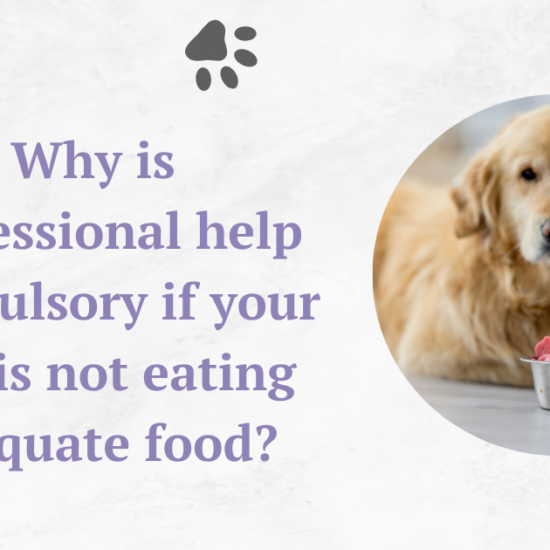Our furry friends are loved and cherished parts of our family; they give us constant companionship, devotion, and affection. Just like humans, pets are subject to accidents and health issues that may require quick attention.
Table of Contents
Introduction
Being prepared with knowledge of pet first aid can make a major difference in protecting the well-being and survival of our furry friends in case of pet emergencies. In this comprehensive guide, we will delve into the field of pet first aid, covering crucial information and providing invaluable recommendations for responding efficiently to various pet emergencies.
Understanding Pet First Aid

Pet owners share a close attachment with their furry companions, and ensuring their well-being is a primary responsibility. Just as we learn basic first aid for people, it’s also crucial to have a thorough understanding of pet first aid to provide prompt care in times of crisis. In this section, we will study the core concepts of pet first aid, its significance, and how it can make a life-saving difference for our furry companions.
What is Pet First Aid?

Imagine a circumstance when your devoted canine friend suddenly chokes on a small thing or your curious kitten ingests a potentially hazardous chemical. Pet first aid comes into play at such vital moments. It refers to the early and proper activities performed to offer basic care to a pet during emergencies or diseases until expert veterinary help becomes available. Pet first aid contains similar techniques customized for the needs of animals, such as CPR and applying pressure to wounds.
The basic goal of pet first aid is to stabilize the pet’s condition, avoid further harm, and buy time until veterinary treatment can be obtained. The fate of a crisis can be greatly influenced by how quickly and effectively action is taken during these periods. While veterinarian care is always the best option for your pet, knowing basic first aid is essential in case of an emergency.
The Value of Pet First Aid
It’s hard to stress the value of knowing basic first aid for pets. All of our furry pets are vulnerable to accidents and medical emergencies. The need for immediate assistance is not limited to humans, our furry friends can also experience pet emergencies. Let’s look at some of the most important factors that make knowing basic pet first aid so crucial:
Relief of Quick Action In Pet Emergencies

Mishaps typically occur when we have the least time to prepare for them. Emergency care is necessary because pets can suddenly become ill, injure themselves, or swallow foreign things. Knowing pet first aid in these situations can help stabilize the pet and buy you some time to get professional treatment if something goes wrong.
Some pet emergencies, such as choking, poisoning, or heatstroke, can quickly become life-threatening if not treated immediately. You may be able to save your pet’s life by administering first aid until you can get them to the vet.
Gained Self-Assurance
Handling pet emergencies might be stressful if you don’t know what to do. With the ability to administer basic first aid, you can ensure the safety of your pet in the event of an emergency.
When given promptly and correctly, pet first aid can lessen the lasting effects of an accident. Immobilizing a fractured leg properly, for example, can avoid further injury, speed healing, and improve your pet’s quality of life after surgery.
Responding compassionately to your pet’s distress might strengthen your bond with it. The trust you share with your pet can grow thanks to your prompt and efficient responses. Your pet will always be grateful that you comforted them in their time of need.
Learning basic pet first aid promotes preparedness and preventative measures. It encourages you to think ahead and take preventative measures by alerting you to potential dangers in your pet’s environment. This involves taking measures to ensure the protection of your pets, such as pet proofing your home.
Common Pet Emergencies and Solutions
Both pets and their owners need to be prepared for the possibility of an unexpected emergency. Knowing what to do in case of an emergency with your pet and having some basic first aid training can be lifesaving. Here we’ll discuss some of the most typical pet crises and offer advice on how to handle them.
Choking and Breathing Difficulties
Choking is a medical emergency that needs rapid attention. Pets, especially curious kittens and young puppies, are prone to choking on foreign objects they find while mouthing their environment. Keep your cool and act quickly if you see your pet choking.
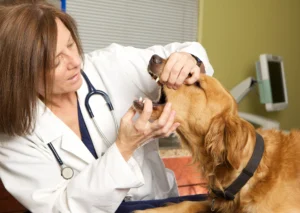
How to Help Large-Breed Dogs When Choking
- Stand behind your dog and place your arms around their belly, just below the ribcage.
- Make a fist with one hand and place it above the abdomen but below the ribcage.
- Using your other hand, exert quick and firm pressure with an upward motion to dislodge the object.
How to Help Cats And Smaller Dogs When Choking
- Hold your pet with their spine against your chest and their head facing down.
- Use the heel of your hand to deliver a quick, gentle, but forceful blow between the shoulder blades.
Keep at it until you’ve broken through the barrier. If the obstruction persists, get your pet to a vet right away.
Poisoning
Pets are naturally curious and may swallow harmful chemicals. Poisoning symptoms are quite variable from one toxin to the next. Here’s what to do if you think your pet has been poisoned:
- Remove your pet from the source of the toxin.
- Contact your veterinarian or a poison control helpline immediately. They can guide you on the appropriate course of action.
- Do not attempt to induce vomiting unless advised to do so by a professional. Inducing vomiting can worsen the situation if done incorrectly.
Injuries and Wounds

Injuries to pets can range from superficial scratches to life-threatening organ damage. If first aid is administered correctly, the severity of these wounds might be lessened until medical assistance arrives.
- Use lukewarm water or a saline solution to clean the wound.
- Stop the bleeding by gently applying pressure with a clean towel or gauze.
- Apply a clean bandage or sterile gauze pad to the wound.
- Use a makeshift splint (a rolled-up magazine, for example) and bandage to immobilize any suspected fractures.
Remember that even seemingly minor wounds can get infected, so veterinarian treatment is always recommended.
Heatstroke

In extremely hot conditions, heatstroke can rapidly turn fatal. Follow these procedures if your pet is showing symptoms of heatstroke, including heavy panting, drooling, weakness, and vomiting:
- Take your pet somewhere cool and shady.
- Reduce their core temperature using cool, wet cloths or water. Extremely cold water can be shocking to the system and should be avoided.
- Make sure they have access to water by offering them modest sips, but don’t force them to drink.
- Immediately consult a veterinarian.
Seizures

Both humans and their pets suffer distress from seizures. Keeping your pet safe is a top priority during an epileptic episode.
- Remove anything that could cause harm to your pet from the area.
- The time of the seizure should be recorded.
- Try to keep calm and keep your hands off your pet’s mouth and tongue if possible.
- Keep your pet warm and comfortable after the seizure, and give it a quiet place to rest.
If your pet is having repeated seizures, it is important to seek the advice of a veterinarian.
Scalds and Burns
Contact with hot objects, fires, or chemicals can cause burns. Timely action is crucial for avoiding infection and alleviating pain:
- Use cool (not cold) water to flush the burn for several minutes.
- A clean, non-stick towel or gauze should be used to cover the burn.
- Immediately take your pet to the vet if it has suffered severe burns.
Preparing a Pet First Aid Kit
Knowing what to do in case of pet emergencies is not enough; you should also have the resources you need on hand. In the event of an emergency, having access to a well-stocked pet first aid kit might be the difference between life and death. Here, we’ll go over what should be in a pet first aid kit and why it’s crucial to keep it up to date.
Note: There might be affiliate links mentioned here. We may receive a commission if you purchase a product through an affiliate link. There is no additional charge for you. Please do your own research before making any online purchases.
Things to Include in a Pet First Aid Kit
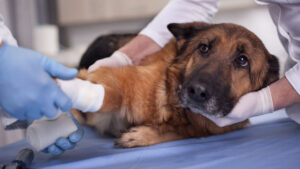
A pet first aid kit is like a toolbox, with its contents tailored to handle a variety of unexpected situations. Here are some of the most important things to include in a pet first aid kit:
- Supplies such as gauze, bandages, and adhesive tape are crucial for treating wounds and stopping bleeding. Adhesive tape is used for securing gauze pads and bandages over wounds to prevent them from moving around.
- Scissors and tweezers are essential for properly removing splinters, dirt, or ticks and for clipping hair surrounding wounds.
- A digital thermometer is a must have in a pet’s first aid kit. Knowing how your pet is feeling physically can be ascertained by taking their temperature regularly. If you want to get an exact reading, use a digital thermometer made for pets.
- Antiseptic wipes can be used to clean wounds and reduce the risk of infection. Some cleaning solutions are dangerous if consumed, so be sure to use pet-safe wipes.
- Hydrogen peroxide (3%), which can cause vomiting, should be used only under a vet’s supervision. This isn’t the best course of action in every circumstance; seek expert guidance first.
- The use of sterile saline solution for washing out eyes and wounds is crucial for removing dirt and promoting hygiene.
- Include any prescriptions given by your veterinarian, as well as pet-friendly pain treatments that can provide temporary respite until you get professional help.
Make sure you have the phone numbers for both your regular vet and the nearest 24-hour emergency veterinary clinic in case of pet emergencies. You’ll have a quick way to get advice or help in a pinch.
Keeping the Pet First Aid Kit Updated
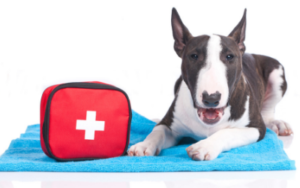
- For a pet first aid kit to be useful, its contents must be current and in good condition. Maintaining a routine of evaluating and restocking your pet’s first aid kit will guarantee that you are ready for anything.
- Many products, including pharmaceuticals and topical treatments, have use-by dates that should be respected. Make sure to check your kit frequently and replace any expired components.
- If your equipment includes anything that runs on batteries, like a digital thermometer, check their status and swap them out if they are low.
- As your pet ages or goes through health changes, their requirements may alter, so it’s important to be flexible. If your vet has suggested any unique supplies or drugs, be sure to include them in your emergency pack.
- It’s not enough to have a pet first aid kit; you also need to know how to use its contents in case of an emergency. Spend some time familiarizing yourself with the contents of the kit and learning some simple first aid procedures.
- After using an item from the kit, replace it as soon as possible so that it is always well stocked in case of an emergency.
- Review your pet’s first aid kit at least once every six months to be sure it still contains everything you need. This can be done at the same time as other chores, including when batteries need to be replaced in smoke alarms.
- Personalize your kit, Include items that are important to your pet, such as a familiar blanket or toy that can ease anxiety.
What to Do in Case of Pet Emergencies
Pet emergencies can be extremely stressful and traumatic. A positive outcome for your furry friend depends on your ability to respond calmly and successfully in these situations. Here, you’ll find a step-by-step plan for dealing with pet emergencies, so you can give your pet the greatest treatment and support possible.
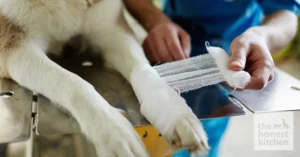
Step 1: Do Not Loose Your Cool
Keeping cool is the first (and arguably most difficult) step in dealing with pet emergencies. You can somewhat make your pet relax by maintaining your own calmness. Relax and think clearly about the subject at hand.
- Find out how serious the situation is; is it something that can be treated at home, or do you need to call for help right away?
- Determine if there are any more threats to you or your pet and remove them before continuing.
Keeping your cool will help you make smart choices and take decisive action.
Step 2: Seek Professional Help
Many veterinary problems require immediate attention from a veterinarian or emergency veterinary facility. These experts can help you sort things out over the phone and give you crucial advice.
- Always be prepared for an emergency by having the number(s) for both your veterinarian’s normal office and an after-hours emergency contact on hand.
- Don’t wait to call your vet or an emergency clinic for advice if you aren’t sure if the problem requires quick attention.
- If the situation is more serious, such as when the animal is having trouble breathing, is bleeding heavily, or shows signs of poisoning, you should call a vet immediately.
The advice they provide you will be unique to your pet and its condition.
Step 3: Perform Basic First Aid
Depending on the severity of the situation, you may need to administer first aid to your pet in order to bring its condition under control. Always put your pet’s and your own safety first.
- If necessary, do as the veterinarian tells you to do over the phone.
- If your pet has a wound, use gauze or a clean cloth to apply pressure and stop the bleeding.
- Burns should be treated with cool water or a clean towel, respectively. Try not to stress out or move your pet any more than is required to ensure its comfort.
- If your pet is choking or having trouble breathing, use the skills you learned in pet first aid.
Keep in mind that no amount of first aid you give your pet can replace the treatment provided by a veterinarian.
Step 4: Seek Safe and Quick Transportation
When time is of the essence and veterinary care is needed immediately, transport safety becomes paramount:
- Involve another person in the transportation of your pet if at all possible.
- To keep your pet safe when traveling, use a pet carrier or other suitable restraint. Both you and your pet can benefit from the reduced stress and risk of subsequent harm that a carrier provides.
- Ensure that your pet has a warm, pleasant trip. Wrap a blanket around the carrier to let the baby feel more at ease.
- Keep your pet’s health in mind and avoid making any unexpected movements that could make the situation worse during transit.
Prevention is Better than Cure

While it’s important to be prepared to administer first aid in the event of pet emergencies, it’s far more efficient to take measures to prevent pet emergencies altogether. Taking Preventative measures to protect your pet will greatly lessen the likelihood of accidents and medical emergencies. Here, We’ll go over some of the most important steps you can take to keep your pet safe and secure at home.
- Supervision and Pet Proofing
Constant vigilance and pet proofing your home are essential measures to take to avoid pet emergencies. Pets, especially young, curious ones, may get into a lot of trouble if they’re left alone. Here are some crucial things to keep in mind:
Supervision
Always keep a close eye on your pet, especially in new situations.
Pet Proofing
Pet proofing is as important as child-proofing especially when you have a young pet in the house.
- Locate and remove anything that could cause harm to your pet. Toxic materials (such as cleaning supplies and drugs) should be locked away, and electrical cords should be concealed and stored out of reach.
- Make sure your garbage cans are out of reach of your pet, as they may go into the trash and swallow something they shouldn’t.
- Keep poisonous and other harmful substances out of reach.
- Make sure your pet has access only to the parts of your home that are safe for them, and block off any other areas that could endanger them.
- Make use of fences and gates as required.
- Keep an eye out for anything small enough to be swallowed or induce choking. Don’t let your pet get into anything like coins, rubber bands, or small toys.
- Recall Command Training
You can strengthen your relationship with your pet and help prevent pet emergencies by teaching it basic commands. Your pet will be safer in unfamiliar environments if it has been trained to recognize its boundaries and respond to your cues.
Recall (“Come”): Teaching your pet to come when called (also known as “Recall” or “Come”) will keep it out of harm’s way and out of traffic. This crucial command can be strengthened through repeated practice.
Recall (“Stay”):The “stay” command is useful for keeping your pet out of harmful areas and in a secure location.
Leash training: A well-trained pet is a pleasure to take on walks and other activities. This safeguards your pet from running away, chasing other animals, or ingesting potentially dangerous materials.
Recall (“Leave It”): Teaching your pet to “leave it” will reduce the likelihood that it will pick up and consume something it shouldn’t.
Socialization: Having your pet properly socialized will allow them to interact with other animals without fear of aggression or harm.
- Scheduled Visits to the Veterinarian
Proactive healthcare measures can also help prevent emergencies with pets. The importance of routine veterinary checkups in detecting health problems before they become emergencies cannot be overstated.
Regular Checkups: Regular checkups provide your vet with the opportunity to assess your pet’s well-being, look for any early warning signs of disease, and suggest preventative care.
Vaccinations: Up-to-date vaccines protect against contagious infections that could lead to a veterinary emergency.
Dental Care: The prevention of oral infections and other health problems can be greatly aided by maintaining good dental health. The health of your pet as a whole benefits from routine dental examinations and cleanings.
Parasite Prevention: Health problems caused by fleas, ticks, and other parasites can be avoided by taking regular preventative steps.
Nutritional Consultation: To keep your pet at a healthy weight and in good overall health, it is important to consult with your veterinarian regarding a nutritious diet.
FAQs
What is pet first aid?
If your pet is ever in an emergency or becomes ill and you don’t have access to veterinary care right away, knowing how to administer basic first aid is essential. Stabilization of the animal’s condition, prevention of additional injury, and gaining precious time to get professional aid are all part of this protocol.
Why is it crucial to know basic pet first aid?
The ability to administer first aid to an animal is vital since it may be the difference between life and death. Pets, like people, can have accidents and medical emergencies like choking, poisoning, injuries, and heatstroke that require immediate attention. You can lessen the severity of these situations by acting quickly and confidently, thanks to your understanding of pet first aid.
How can I save the life of my pet by using pet first aid?
You can help stabilize your pet’s condition until you can get them to a vet by learning pet first aid, so you can act swiftly and confidently in an emergency. Take immediate action to enhance your pet’s chances of survival, such as opening a blocked airway or stopping bleeding.
What are pet emergencies?
Injuries, burns, heat stroke, convulsions, and choking are some of the most common veterinary emergencies. The way you handle these scenarios can have a major impact on the safety of your pet.
Can first aid for pets replace visits to the vet?
Pet first aid is not meant to replace visits to the vet. While this is helpful for getting your pet stabilized, a veterinary evaluation and treatment are still necessary for a full recovery.
What should I have in a pet first aid kit?
Gauze, bandages, adhesive tape, scissors, tweezers, a digital thermometer, antiseptic wipes, saline solution, pet-friendly pain medicines, and the numbers for both your regular vet and an emergency veterinary facility should all find a home in your pet’s first aid kit.
How often must I replenish a pet’s first aid kit?
Check the expiration dates and stock up on new goods for your pet’s first aid kit at least once every six months. Immediately toss out stale goods and replenish depleted stocks.
How do I keep my cool during pet emergencies?
In the event of pet emergencies, maintaining composure is crucial. Remember that your pet can sense your emotions and take a few deep breaths before reacting. Keeping your cool will allow you to provide better care and make better decisions.
When should I take my pet to the emergency vet?
It’s vital to get in touch with a vet or emergency veterinary facility right away in the event of a critical emergency, such as trouble breathing, significant bleeding, poisoning, or seizures. You can call them up and get some advice before your pet even gets there.
How do I keep my pet safe from pet emergencies?
Supervision, pet proofing your home, educating your pet with recall orders, and routine veterinary checkups can all help you avoid an emergency situation with your pet. Emergency situations can be avoided, or at least minimized, if you keep an eye out for dangers and keep your pet healthy.
Conclusion
As a responsible pet owner, you should know how to administer basic first aid in the event of an emergency involving your pet. You may be of great help to your cherished furry friend in times of crisis if you are prepared for typical pet crises, have a well-stocked first aid kit, and know what to do. In a life-or-death situation, every second counts; therefore, it’s crucial that you move quickly and with knowledge. Be the hero your pet needs you to be by remaining alert and well-informed in times of distress





